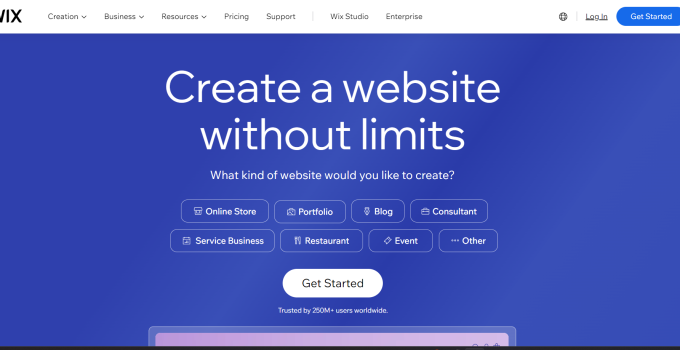In today’s digital landscape, a website is a cornerstone for any business. But as your company flourishes, your website needs to keep pace. Wix, a popular website builder known for its user-friendly interface, can be a great starting point. However, as your business ambitions grow, Wix’s limitations can become a bottleneck. This blog post dives into the potential drawbacks of Wix for growing businesses, particularly when it comes to Search Engine Optimization (SEO) and scalability. We’ll explore how Wix might hinder your website’s ranking potential and ability to handle a surge in content and traffic. We’ll also discuss alternative website builder platforms that offer more control and flexibility for businesses aiming to achieve long-term online success.
Table of Contents
Limited Control Over Technical SEO: Why Wix Might Slow Your Website Down
Wix is a popular website builder known for its user-friendly drag-and-drop interface. It allows anyone to create a beautiful website with minimal technical knowledge. However, when it comes to Search Engine Optimization (SEO), Wix’s limited control over technical SEO can hold your website back. In this post, we’ll explore how Wix can make it difficult to optimize three crucial SEO factors: site speed, URL structure, and mobile-friendliness.
1. Site Speed:
- Code Bloat: Wix’s visual editor can lead to bulky code behind the scenes. This extra code can slow down your website’s loading time, which is a major ranking factor for search engines like Google.
- Limited Caching Options: Wix offers some caching options, but they might not be as customizable as other platforms, making it harder to fine-tune your website’s speed.
2. URL Structure:
- Non-descriptive URLs: Wix automatically generates URLs that are often long and contain random characters. These don’t tell search engines or users much about the content of the page, making them less SEO-friendly.
- Limited Customization: While Wix allows some editing of URLs, it might not offer the flexibility to create clear and concise URLs optimized for relevant keywords.
3. Mobile-Friendliness:
- Template Dependence: Wix offers mobile-responsive templates, but extensive customization within those templates could lead to a less than optimal mobile experience.
- Limited Control Over Mobile View: You might not have as much control over how your website looks and functions on different mobile devices compared to other platforms.
What can you do?
- Prioritize lightweight elements: Focus on using high-quality images and videos optimized for web to avoid slowing down your site.
- Utilize Wix SEO tools: Wix offers basic SEO tools like meta tag and title tag editing. Utilize these features to the best of your ability.
- Consider alternatives: If SEO is a major priority for your website, you might want to consider platforms like WordPress that offer more granular control over technical SEO.
Remember: Wix is a great option for building a simple website. However, if you’re serious about ranking well in search engines, it’s important to understand the limitations it has regarding technical SEO. By being aware of these limitations and taking steps to mitigate them, you can still achieve success with your Wix website.
Code Bloat: Why Wix’s Drag-and-Drop Convenience Can Come at a Cost
Wix’s drag-and-drop interface is a double-edged sword. While it makes website creation accessible for everyone, it can also lead to a hidden culprit affecting your website’s performance: code bloat. Let’s delve into how this happens and why it matters.
Behind the Scenes of Drag-and-Drop:
Imagine your website as a house. Wix’s drag-and-drop interface lets you visually arrange furniture (text, images, buttons) without needing to build the walls or lay the foundation (code). This is convenient, but unlike a physical house, the website’s code acts as both the blueprint and the building materials.
Here’s where code bloat comes in:
- Redundancy: When you drag-and-drop elements, Wix might generate more code than strictly necessary. This can be like having duplicate furniture instructions in your house plans.
- Hidden Functionality: Wix offers a variety of features through its drag-and-drop options. Each feature adds its own code snippets, even if you don’t use all the functionalities. It’s like having plumbing instructions in your plans even if you only plan to use the electrical system.
- Limited Customization: Wix provides pre-built elements with limited control over their internal code. This can be like having pre-fabricated walls that might include unnecessary features you can’t remove.
The Impact of Code Bloat:
All this extra code adds weight to your website. When a visitor opens your site, their browser needs to download and interpret all this code before displaying the content. This can lead to:
- Slower Loading Times: A bulky website takes longer to load, frustrating visitors and hurting your SEO ranking since Google prioritizes fast-loading websites.
- Increased Bounce Rate: Visitors who experience slow loading times are more likely to leave your website before they even see your content.
- Higher Server Costs: With more code to manage, your website might require more server resources, potentially increasing your hosting costs.
What can you do?
- Be mindful of elements: Choose elements you truly need and avoid overloading your pages with unnecessary features.
- Optimize images: Large, unoptimized images are a major source of code bloat. Use tools to compress images without sacrificing quality.
- Consider alternatives: If website performance is critical, platforms like WordPress offer more control over code, allowing for cleaner and lighter websites.
Remember: Wix is a great tool for building basic websites, but its drag-and-drop simplicity can come at a cost. By understanding code bloat and taking steps to minimize it, you can ensure your website loads quickly and delivers a smooth user experience.
Content Management Challenges: Why Keeping Your Wix Website Fresh Can Be a Struggle
Keeping your website content fresh and engaging is crucial for SEO. Search engines like Google favor websites that are constantly updated with new information. Unfortunately, Wix’s content management system (CMS) can present some hurdles to those aiming for SEO success. Here’s how:
- Limited Editing Options: Wix’s drag-and-drop editor offers a user-friendly way to arrange content, but it might not provide the granular control needed for SEO-friendly optimization. For instance, you might have limited control over formatting elements like H1 tags, subheadings, and bolding, which are crucial for structuring your content and incorporating relevant keywords.
- Lack of Bulk Editing Tools: Updating a large website on Wix can be a time-consuming task. Unlike some platforms that offer bulk editing features, you might need to edit each page individually on Wix. This can be a real burden if you have a content-heavy website that requires frequent updates.
- Version Control Issues: Wix’s version control system might not be as robust as other platforms. Version control allows you to track changes made to your content and revert to previous versions if needed. Weaker version control on Wix can make it difficult to collaborate with multiple editors or accidentally overwrite important updates.
- Limited Scheduling Options: While Wix allows you to schedule posts to be published in the future, it might not offer the same level of flexibility as some SEO plugins available on other platforms. This can make it trickier to plan and automate your content publishing strategy.
How to Work Around These Limitations:
- Plan your content structure: Before adding content, establish a clear hierarchy using H1 tags, H2 tags, and bullet points to optimize readability and SEO.
- Update strategically: Focus on updating high-performing content and prioritize new content that targets relevant keywords.
- Utilize external content calendars: Use project management tools or spreadsheets to track content updates and collaboration.
- Schedule social media promotion: Even if you can’t schedule blog posts directly, plan your social media promotions in advance to generate buzz around new content.
Remember: Wix offers a user-friendly platform for creating websites, but keeping your content fresh for SEO might require extra planning and workarounds. By understanding these limitations and employing strategic solutions, you can still achieve your content marketing goals on Wix.
Internal Linking Roadblocks: Why Connecting Your Wix Website Can Be Tricky
Internal linking is the art of strategically linking pages within your website to each other. It helps search engines understand the structure and hierarchy of your content, ultimately improving your website’s SEO performance. While Wix offers linking functionalities, its limitations can make building a strong internal linking strategy challenging. Here’s why:
- Limited Anchor Text Options: Anchor text is the clickable text within a link. Ideally, it should be descriptive and relevant to the linked page. Wix might restrict your ability to fully customize anchor text, making it difficult to incorporate targeted keywords or informative phrases that both users and search engines can understand.
- Navigation Menu Constraints: Wix offers pre-built navigation menus, which can limit the flexibility of adding internal links throughout your website. You might not have complete control over where and how internal links appear within your navigation structure.
- Difficulties with Contextual Linking: Contextual linking involves embedding relevant links within the body of your content. While Wix allows adding hyperlinks, it might not be as intuitive for seamlessly integrating internal links within your writing compared to other platforms with dedicated linking buttons or plugins.
- Lack of Internal Linking Reports: Understanding how users navigate your website through internal links is crucial for optimizing your linking strategy. Wix might not offer built-in reports or analytics to track internal linking effectiveness, making it difficult to measure the impact of your linking efforts.
Overcoming Internal Linking Hurdles on Wix:
- Manual Linking: While it might be more time-consuming, manually editing your content to incorporate relevant internal links with descriptive anchor text is still possible on Wix.
- Utilize Menus Strategically: Plan your navigation menus carefully to include links to key pages within your website’s hierarchy.
- Content-Focused Linking: Focus on adding natural-sounding internal links within your content whenever relevant to the topic and user experience.
- External Analytics Tools: Integrate external analytics tools like Google Search Console to track user behavior and identify potential internal linking gaps.
Remember: Building a strong internal linking structure is crucial for SEO. While Wix might present some limitations, by being resourceful and focusing on strategic linking within your content, you can still improve your website’s navigation and searchability.
Meta Description and Title Tag Troubles: Why Wix Can Clip Your SEO Wings
Meta descriptions and title tags are like mini-billboards for your website in search engine results pages (SERPs). They entice users to click and give search engines a glimpse of your content’s value. Unfortunately, Wix’s limitations in customizing these crucial elements can hinder your SEO efforts. Here’s how:
- Character Restrictions: Wix might enforce character limits for meta descriptions and title tags that are stricter than search engine recommendations. This can make it difficult to craft compelling and informative snippets within those limitations.
- Limited Template Options: Wix might offer pre-defined templates for meta descriptions and title tags, restricting your ability to fully customize them for each page. These templates might not provide enough flexibility to incorporate unique keywords and tailor messaging to specific content.
- Difficulty Targeting Multiple Keywords: Ideally, your title tags and meta descriptions should target relevant keywords that users might search for. Wix’s limitations could make it challenging to optimize for several keywords within a single page’s meta elements.
- Inconsistent Targeting Across Pages: Without the ability to easily customize meta descriptions and title tags, it can be difficult to ensure consistency in keyword targeting and messaging across your entire website. This can confuse search engines and make it harder for them to understand the overall theme and value proposition of your site.
Optimizing Your Wix Website Despite Limitations:
- Prioritize Keyword Research: Identify the most relevant keywords for each page and focus on incorporating them within the character limits allowed by Wix.
- Craft Compelling Snippets: Even with limited characters, strive to write clear, concise, and action-oriented meta descriptions and title tags that entice users to click.
- Utilize Available Tools: Wix might offer basic SEO tools within its editor. Explore these tools to see if there are options to customize meta descriptions and title tags within the allowed parameters.
- Consider External SEO Plugins: Wix integrates with some third-party SEO plugins that might offer more flexibility in managing meta descriptions and title tags. However, this might add additional costs.
Remember: While Wix might restrict your ability to fully optimize meta descriptions and title tags, you can still create compelling snippets that improve your click-through rate (CTR) and SEO performance. By prioritizing keyword research and crafting concise, informative messages, you can make the most of the tools Wix provides.
Locked Under the Hood: Why Wix Can Hinder Advanced SEO Techniques
Wix’s user-friendly interface makes website creation accessible, but it comes at a cost for SEO enthusiasts. One major limitation is the lack of access to the raw code underlying your website. This can significantly hinder your ability to implement advanced SEO techniques that require granular control. Here’s why direct code access is crucial for advanced SEO:
- Technical SEO Optimizations: Advanced SEO involves fine-tuning various technical aspects of your website that impact search engine crawling and indexing. Without access to the code, you might be unable to optimize elements like server response time, robots.txt directives, or sitemap configuration – all crucial factors for search engine visibility.
- Schema Markup Implementation: Schema markup is a way to provide search engines with richer information about your content, potentially leading to richer snippets in search results. While Wix offers basic schema markup options, the lack of code access limits your ability to implement complex schema markup for specific content types like products, events, or recipes.
- Custom Plugin Integration: Powerful SEO plugins can automate tasks, provide deeper analytics, and offer advanced features like broken link checking or internal linking suggestions. However, without code access, you’re limited to the SEO functionalities built into Wix, which might not cater to your specific needs.
- JavaScript Rendering Challenges: Some websites heavily rely on JavaScript to render content. Search engines might not always process JavaScript effectively, potentially hindering your website’s visibility. Without code access, you might have limited options to address these rendering issues and ensure search engines can properly crawl and understand your content.
Working Around Wix’s Code Limitations:
- Seek Wix SEO Alternatives: Wix offers built-in SEO tools and integrates with some third-party SEO apps. Explore these options to see if they can address your basic SEO needs.
- Consider a Hybrid Approach: If SEO is a top priority, consider building a core website on Wix with its user-friendly interface and then hosting a separate blog section on a platform like WordPress that offers greater code access for advanced SEO optimization.
- Consult an SEO Specialist: A qualified SEO specialist can assess your website and suggest strategies to work around Wix’s limitations or recommend alternative platforms better suited for advanced SEO.
Remember: Wix is a great platform for building basic websites, but its lack of code access can restrict your ability to implement advanced SEO techniques. By understanding these limitations and exploring alternative solutions, you can still achieve good SEO results, but it might require more work compared to platforms offering full code control.
Blindfolded Optimization: Why Wix Can Limit Your View of Your SEO Performance
Making informed decisions about your SEO strategy requires in-depth data and insights. Unfortunately, Wix’s limitations on analytics integration can make it difficult to utilize powerful tools like Google Search Console (GSC) to its full potential. Here’s how Wix might restrict your access to valuable SEO data:
- Limited Native Analytics: While Wix offers basic website analytics, they might not provide the same level of detail and granularity as dedicated SEO tools like GSC. This can make it challenging to understand how users find your website through search engines, identify keyword ranking performance, or diagnose crawling errors that could be hindering your SEO.
- Difficulties with Data Ownership: Wix might have limitations on exporting your website data in formats compatible with other analytics platforms like GSC. This can make it cumbersome to consolidate data and gain a holistic view of your website’s SEO performance.
- Restricted Access to GSC Features: Even if you connect your Wix website to GSC, some functionalities might be limited. For instance, you might not be able to leverage advanced features like custom reports or URL parameter handling, which can provide valuable insights into specific aspects of your SEO strategy.
Seeing Beyond Wix’s Analytics Walls:
- Utilize Third-party Integration: Explore third-party SEO plugins that integrate with Wix and offer deeper analytics capabilities. However, these might add additional costs and may not provide the same level of detail as GSC.
- Focus on Wix’s Available Data: Make the most of the analytics Wix offers, even if they are basic. Analyze data like traffic sources, user behavior, and popular pages to glean some insights into your SEO performance.
- Connect to Google Analytics: While Wix might limit GSC integration, connecting your website to Google Analytics can still provide valuable data on user acquisition and website traffic. Combine this data with Wix’s analytics for a more comprehensive picture.
- Consider a Hybrid Approach: If in-depth SEO insights are crucial, explore hosting a separate blog section on a platform like WordPress that offers full GSC integration for detailed SEO analysis.
Remember: Wix offers basic website analytics, but they might not be sufficient for serious SEO optimization. By exploring alternative solutions and combining data from various sources, you can still gather valuable insights to guide your SEO strategy on Wix. However, for the most powerful SEO tools and in-depth data analysis, platforms offering full GSC integration might be a better choice.
Wix and the Growing Pains: Why Your Thriving Website Might Outgrow Wix
Wix is a fantastic platform for building a basic website quickly and easily. However, as your website grows in content and traffic, Wix’s limitations can become a bottleneck, hindering your website’s scalability. Here’s how Wix might struggle to handle a website on the rise:
- Performance Issues: As your website accumulates content (pages, images, videos), the code bloat we discussed earlier can become a major problem. This can lead to slower loading times, frustrating users and potentially impacting your SEO ranking. Wix’s limited control over server resources might make it difficult to optimize performance for a larger website.
- Database Constraints: Wix utilizes a shared database environment. This means your website’s performance can be affected by the activity of other websites on the same server. With a rapidly growing website and database, this shared environment might not offer the resources and scalability needed for optimal performance.
- Content Management Challenges: Managing a large website with numerous pages and content pieces can be cumbersome on Wix. The lack of bulk editing tools and limited version control systems can make updating and maintaining your website more time-consuming and error-prone.
- Plugin Limitations: While Wix offers some apps and plugins, they might not be as robust or customizable as those available on other platforms like WordPress. This can restrict your ability to add advanced functionalities or features needed for a complex website.
Scaling Up Beyond Wix:
- Consider a Platform Migration: If your website experiences significant growth and Wix’s limitations become a burden, migrating to a platform like WordPress might be necessary. WordPress offers greater control over code, server resources, and a wider range of plugins for scalability and functionality.
- Optimize Wix for Growth: If migration isn’t feasible, explore ways to optimize your Wix website for growth. Prioritize high-quality, optimized images and videos. Utilize caching plugins and explore Wix’s SEO tools to maximize performance.
- Plan for a Hybrid Approach: You could potentially maintain a core website on Wix while hosting a separate blog or content section on a platform like WordPress that offers better scalability for managing large amounts of content.
Remember: Wix is a great solution for simple websites, but it might not be the best choice for a website with ambitions of significant growth and complex content needs. By understanding these limitations and planning for scalability, you can make informed decisions about your website’s future and ensure it can continue to thrive.
Stuck in the Wix Web: Why Migrating Away Can Be a Sticky Situation
Wix makes creating a website a breeze, but what if your website outgrows Wix’s capabilities or your SEO needs become more demanding? Migrating your website to a different platform like WordPress can be a complex and expensive undertaking. Here’s why getting locked into Wix can be a challenge:
- Limited Content Export Options: Wix might not offer straightforward ways to export your website content (text, images, videos) in formats easily compatible with other platforms. This can make it difficult to seamlessly transfer your content to a new website.
- Design Reconstruction Challenges: Wix websites are built using a drag-and-drop interface. Replicating the same design on a new platform can be time-consuming, especially if you’ve heavily customized your Wix website. Third-party tools might be available to help migrate the design, but they might not be perfect and could require additional work.
- SEO Impact: Migrating a website can lead to temporary dips in SEO performance as search engines re-crawl and index your website on the new platform. Rebuilding your internal linking structure and ensuring proper redirects for old URLs can be crucial to minimize SEO losses during migration.
- Hidden Migration Costs: While Wix itself might not charge for migration, the process often requires professional help. Developers can extract your content, rebuild your design, and ensure a smooth SEO transition, but their expertise comes at a cost.
Planning for a Potential Escape:
- Choose a Flexible Design: When building your Wix website, consider using a more generic and adaptable design that could be more easily recreated on another platform if needed.
- Maintain Offline Backups: Regularly export your website content (text, images) and store it offline. This can make it easier to migrate your content if you ever decide to switch platforms.
- Plan for SEO from the Start: Focus on creating high-quality content, optimizing for relevant keywords, and building a strong internal linking structure on Wix. This can help minimize SEO impact during a potential migration.
- Factor in Migration Costs: When budgeting for your Wix website, consider the possibility of future migration and factor in potential costs associated with professional help.
Remember: Wix is a user-friendly platform, but it can lock you in with limited content portability and potential migration challenges. By being aware of these limitations and planning for potential future growth, you can make informed decisions about your website and avoid getting stuck in a Wix web if your needs evolve.
Design First, SEO Second: Why Wix Might Make You Look Good, But Not Rank High
Wix’s drag-and-drop interface is undeniably user-friendly and visually appealing. It empowers anyone to create a beautiful website without needing extensive coding knowledge. However, this design-centric approach can come at a cost for SEO. Here’s how Wix might prioritize aesthetics over technical SEO best practices:
- Limited Control Over Technical SEO: Wix offers pre-built templates and functionalities that might not be optimized for crucial SEO factors like site speed, URL structure, or mobile-friendliness. While some customization is possible, it might not be enough for in-depth technical SEO optimization.
- Focus on Visual Appeal: Wix’s interface encourages creativity and visual customization. This can lead to websites with complex layouts, heavy media elements, and bulky code – all of which can slow down loading times and negatively impact SEO.
- Limited SEO Tools: While Wix offers basic SEO tools for meta descriptions and title tags, it might lack the advanced features available on other platforms like keyword research tools, sitemap generation, or broken link checkers. These tools can be vital for optimizing your website’s technical SEO performance.
- Drag-and-Drop’s Hidden Costs: The ease of Wix’s drag-and-drop interface can lead to creating websites with bloated code and unnecessary elements. Search engines prioritize clean and lean code, so these hidden complexities can hinder your website’s ranking potential.
Finding the Balance Between Design and SEO on Wix:
- Prioritize Content Quality: Even with Wix’s limitations, focus on creating high-quality, informative content optimized for relevant keywords. This remains a crucial factor for search engine ranking.
- Utilize Available SEO Tools: Explore Wix’s built-in SEO tools to optimize meta descriptions, title tags, and basic on-page SEO elements.
- Focus on User Experience (UX): While aesthetics are important, prioritize a user-friendly website structure with clear navigation and fast loading times. This will not only improve your SEO but also keep visitors engaged.
- Consider Third-party Integrations: Wix integrates with some SEO plugins that might offer additional functionalities and insights. However, these can add extra costs and might not fully address technical SEO limitations.
Remember: Wix is a great platform for creating visually appealing websites, but SEO optimization can be an uphill battle. By understanding the limitations and focusing on high-quality content and user experience, you can still achieve good SEO results on Wix. However, for websites where SEO is paramount, platforms offering greater control over technical SEO might be a better long-term solution.
Why Choose Instant Web Tools?
Instant Web Tools empowers businesses with the tools and resources they need to thrive in the digital age. From customizable templates and advanced SEO capabilities to e-commerce integration and robust analytics, Instant Web Tools provides everything you need to build and grow a successful online presence.
Don’t let your website builder hold you back from achieving your business goals. If you’re feeling limited by platforms like Wix and yearning for greater flexibility and growth opportunities, it may be time to explore alternative solutions. Contact Instant Web Tools at 513-802-4668 to learn how we can help you unlock your business’s full potential. And for ongoing insights and tips on maximizing your online presence, subscribe to dennis.tips.
Remember, your website should be a catalyst for growth, not a barrier to success. Choose a website builder that empowers you to reach new heights and dominate your industry.





